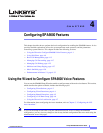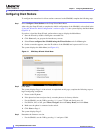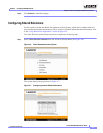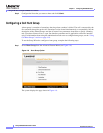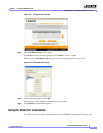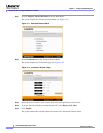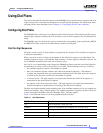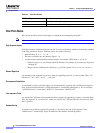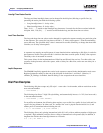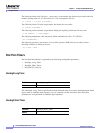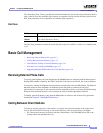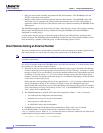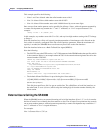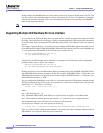
4-9
Linksys SPA9000 Administrator Guide
Document Version 3.01
Chapter 4 Configuring SPA9000 Features
Using Dial Plans
Using Dial Plans
This section describes the dial plan features of the SPA9000. It also explains how to configure and write
scripts and provides a reference describing the use of each dial plan parameter. For information about
dial plans for the Auto-Attendant, refer to
Chapter 5, “Configuring the LVS Auto-Attendant.”
Configuring Dial Plans
The SPA9000 allows each line to be configured with a distinct dial plan. The dial plan specifies how to
interpret digit sequences dialed by the user, and how to convert those sequences into an outbound dial
string.
The SPA9000 syntax for the dial plan closely resembles the corresponding syntax specified by MGCP
and MEGACO. Some extensions are added that are useful in an end-point.
Dial Plan Digit Sequences
The plans contain a series of digit sequences, separated by the | character. The collection of sequences
is enclosed in parentheses.
When a user dials a series of digits, each sequence in the dial plan is tested as a possible match. The
matching sequences form a set of candidate digit sequences. As more digits are entered by the user, the
set of candidates diminishes until only one or none are valid.
Any one of a set of terminating events triggers the SPA9000 to either accept the user-dialed sequence
and transmit it to initiate a call, or else to reject it as invalid. The terminating events are as follows:
• No candidate sequences remain—The number is rejected.
• Only one candidate sequence remains, and it has been matched completely—The number is
accepted and transmitted after any transformations indicated by the dial plan, unless the sequence
is barred by the dial plan, in which case the number is rejected.
• A timeout occurs—The digit sequence is accepted and transmitted as dialed if incomplete, or
transformed as per the dial plan if complete.
• An explicit “send” (user presses the # key)—The digit sequence is accepted and transmitted as
dialed if incomplete, or transformed as according to the dial plan if complete.
The time-out duration depends on the matching state. If no candidate sequences are as yet complete (as
dialed), the Interdigit_Long_Timeout applies. If a candidate sequence is complete, but there exists one
or more incomplete candidates, then the <Interdigit_Short_Timeout> applies.
Table 4-1 describes the entries to use when programming the dial plan.
Table 4-1 Dial Plan Entries
Dial Plan Entry Function
*xx Allows arbitrary 2-digit star code
[3469]11 Allows x11 sequences (for example, 311, 411, 611, 911)
0 Dials operator
00 Dials international operator
[2-9]xxxxxx Dials US local number



